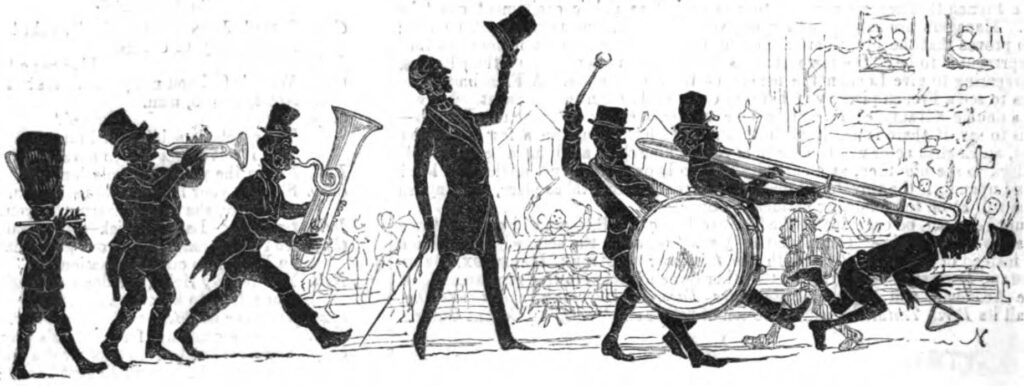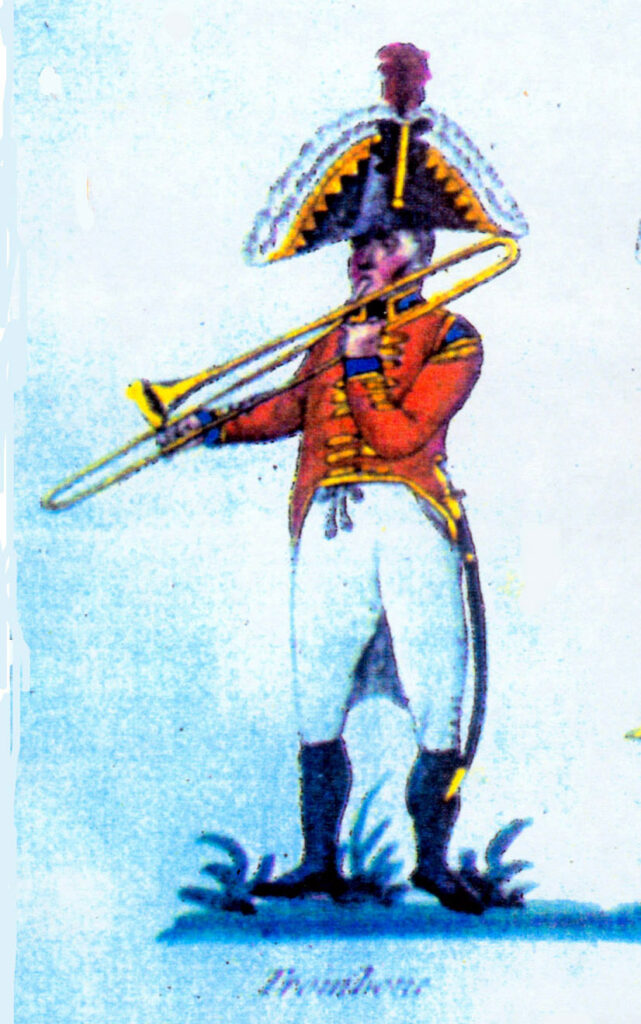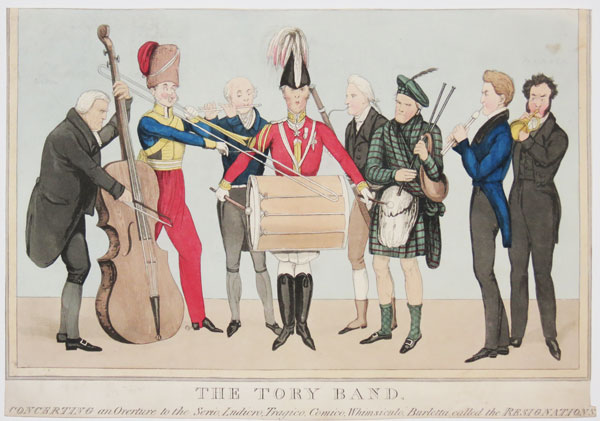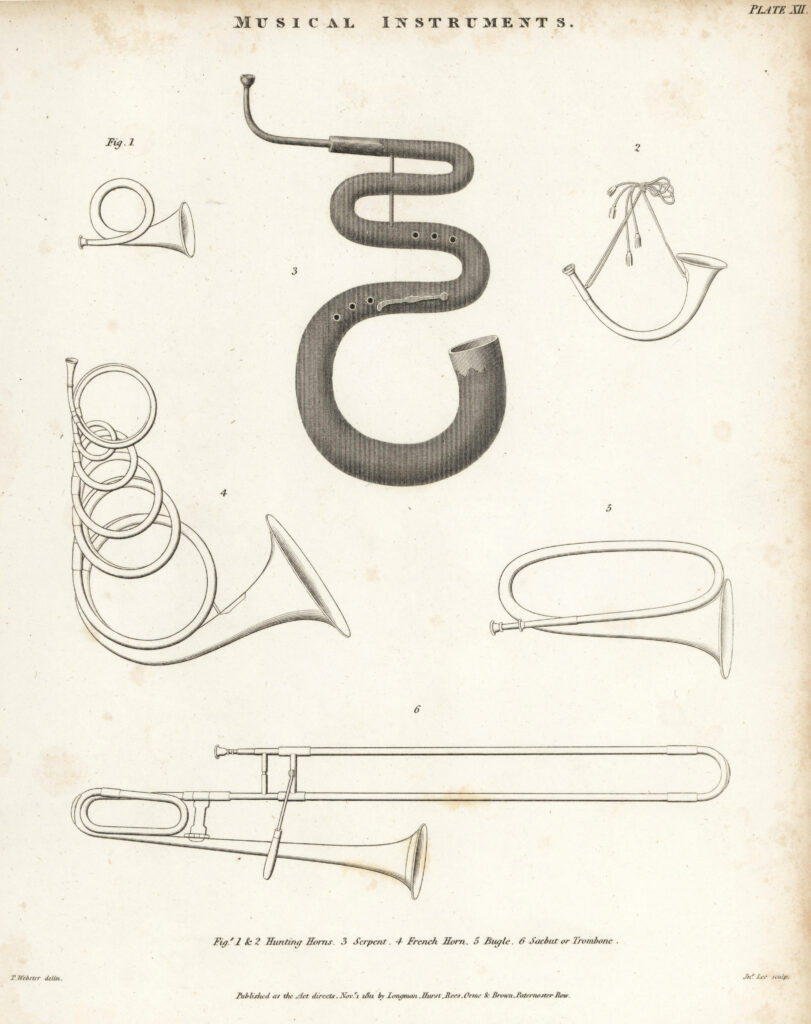Trombone

In the early to mid 18th century, the trombone in the UK was regarded as languishing in the depths of obscurity due to an almost complete lack of players and instruments alike.
The information listed below is aimed at opening up awareness, that the trombone did in fact enjoy a colourful and regular place within musical life in London and the UK from the mid 1770’s, due to an influx of players from overseas.
Rare appearances were documented from as early as the 1740’s, including performances of The Dead March from Handel’s Oratorio, Saul at the New Theatre, Hay-Market on 26th February 1741[1]Herbert, Trevor – Sackbut in England in the 17th & 18th Centuries. Early Music, Volume XVIII, Issue 4, November 1990. p.612, and London Daily Post 1741, and at the Coronation of King George III & Queen Charlotte, on Tuesday 22nd September (1761), when two sackbuts were situated either side of a double courtal as part of the procession.[2]The Royal Magazine/Gentleman’s Monthly Companion prints (London 1761), and Trombone History from 15th to 20th Century, … Continue reading Other appearances include in Thomas Linley Jnr’s Shakespear Ode (1776)[3]Herbert, Trevor – The Trombone. Yale University Press, 2006, p.123., and a single trombone was used in one Concert of Ancient Music (1776) in London. In addition, the trombone was documented as being played in provincial theatres elsewhere in the UK in as early as 1776.
Examples of Trombone use in the UK:
1776 – London “Concert of Ancient Music”.[4]Spitzer, John & Zaslaw, Neal – The Birth of the Orchestra History of an Institution 1650-1815. Oxford University Press 2005, p.184
1787 – Samuel Arnold Oratorio in Liverpool – one trombone.[5]Spitzer, John & Zaslaw, Neal – The Birth of the Orchestra History of an Institution 1650-1815. Oxford University Press 2005, p.325
1783 – In his memoirs renowned Vauxhall Gardens oboist W. T. Parke (1761-1847) recalls trombones in the Cold Stream Guards Band.[6]Hind, Harold C. – Military Band. Grove Vol. 5
1784 – London, Handel Commemorations – six trombones. Account by Charles Burney.[7]Spitzer, John & Zaslaw, Neal – The Birth of the Orchestra History of an Institution 1650-1815. Oxford University Press 2005, p.325
1787 and 1789 – Samuel Arnold listed four trombones in two of his Oratorios, compiled from Handel’s music: Redemption & The Triumph of Truth.[8]Guion, David – Trombone – Its History and Music. 1697-1811. Psychology Press, 1988, p.147
1789 – Sees the first UK advertisement of “thrombones” (sic.) for sale in Longman & Broderip at London’s Cheapside premises.[9]Herbert, Trevor – The Trombone. Yale University Press, 2006, p.124
1790s – Composer/writer John Marsh (1752-1828) records in his Journal that he attended several of Haydn’s famous London concerts, and on 21 February 1801, on hearing the first London performance of Mozart’s Requiem, which features three trombones, he noted it was “very indifferently perform’d”.[10]Robins, Brian – An introduction to the Journals of John Marsh. Huntington Library Quarterly Vol. 59, No. 1 (1996). University of Pennsylvania Press, p.140
1792 – Advertisement of additional instruments including a trombone to strengthen the bass line.[11]McVeigh, Simon – The Professional Concert and Rival Subscription Series in London 1783-1793. Royal Musical Association Research Chronicle No. 22 (1989). Taylor & Francis, Ltd., p.14
1793 – Mr Salomon’s Concert, Hanover Square Rooms – one trombone listed.[12]McVeigh, Simon – The Professional Concert and Rival Subscription Series in London 1783-1793. Royal Musical Association Research Chronicle No. 22 (1989). Taylor & Francis, Ltd., p.123
1793 – Covent Garden Theatre – one trombone listed.[13]Spitzer, John & Zaslaw, Neal – The Birth of the Orchestra History of an Institution 1650-1815. Oxford University Press 2005, p.566
1793 – Salomon’s Concerts, Covent Garden, London – one trombone.[14]Spitzer, John & Zaslaw, Neal – The Birth of the Orchestra History of an Institution 1650-1815. Oxford University Press 2005, p.567
1793 – “No trombone came for either act…” Sir George Smart recalls.[15]Taylor, Ian – Music in London and the Myth of Decline: From Haydn to the Philharmonic. Cambridge University Press 2010. p.172
1794 – Worcester Festival had two brass players doubling trombone and horn.[16]https://kimballtrombone.com/trombone-history-timeline/trombone-history-18th-century/
1798 – London: the opera, Blue Beard by Michael Kelly features the trombone.[17]Guion, David – Trombone – Its History and Music. 1697-1811. Psychology Press, 1988, p.147
1799 – London: Michael Kelly writes for trombone in incidental music to Richard Brinsley Sheridan’s play, Pizzaro.[18]Guion, David – Trombone – Its History and Music. 1697-1811. Psychology Press, 1988, p.147
1805 – Charles Burney, Musicologist writes “Tromboni & double-drums are now so frequently used at the opera, oratories and in symphonies, that they become a nuisance…..”.[19]Guion, David – Trombone – Its History and Music. 1697-1811. Psychology Press, 1988, p.147
1805 – Liverpool Music Festival – three trombones, Mariotti, Zingman & Flack, are listed as performing in Arnold’s Redemption, and Haydn’s Creation.[20]Some Festival Programmes of the Eighteenth and Nineteenth Centuries: 3. Liverpool and Manchester. R.M.A. Research Chronicle No. 7 (1969). Published By: Taylor & Francis, Ltd. on behalf of the … Continue reading
1807 – John Marsh in his Hints to Young Composers of Instrumental Music, explains that trombones are used more often than is strictly indicated in scores: “Composers seldom insert parts for them, but omit them to be added later, as required, which can be easily done from the score by any composer or judge of composition”. He then complains, “The growing practice of over-straining the choruses, by trombones and double drums too forcibly beaten, what should occasionally produce an awful and grand effect, degenerates into continued noise and clatter”.[21]Guion, David – Trombone – Its History and Music. 1697-1811. Psychology Press, 1988, p.88-89
1818 – Covent Garden Theatre – one trombone as part of the orchestra.[22]Spitzer, John & Zaslaw, Neal – The Birth of the Orchestra History of an Institution 1650-1815. Oxford University Press 2005, p.302
1818 – King’s Theatre – one trombone as part of the orchestra.[23]Spitzer, John & Zaslaw, Neal – The Birth of the Orchestra History of an Institution 1650-1815. Oxford University Press 2005, p.572

The trombone was notably reintroduced to wide acclaim in 1784 when no less than six trombones partook in the elaborate celebrations to commemorate the birth of Handel at Westminster Abbey and the Pantheon. This extravagant concert employed “every species of instrument”.
During the 18th Century doubling on trombone was commonplace in military bands such as the Duke of York’s Band (c.1780–c.1810), at various Pleasure Gardens, London’s West End, and regional UK theatres and opera houses, demonstrating how the trombone’s use was becoming increasingly widespread as a mainstay instrument in all genres of UK music making.
However, trombonists in the UK were unanimously European players (primarily from Germany, France & Italy) who assisted in bringing the instrument back to life in the UK.
Image – Close up of a trombonist from an illustration of the Duke of Gloucester’s Band, from the the 3rd Regiment of Foot Guards (now the Scots Guards), in 1811.
London’s Premiere Trombonists of the 18th & 19th Century

Signor Antonio Mariotti
Born 9th July 1757 (Bologna) – died 8th September 1843 (London) (fl.1793–1838).
One of Mariotti’s first appearances in the UK following his arrival from Paris was a performance of Handel’s Messiah (September 1792) for The Earl of Warwick. He was listed as Signor Mariotti (trombone) alongside Mr. Holmes (the well known bassoonist).
Considered London’s leading trombonist, Mariotti played for the prestigious Drury Lane Band at the King’s Theatre (1817-18), The Haymarket Theatre, the Oxford Meeting (1793), on bass trombone in York Minster (September 1825), and in countless other concerts throughout the UK.
Mariotti was close friends with the famed virtuoso bassist Antonio Dragonetti, who also performed extensively in the UK during the same period. Dragonetti assisted Mariotti financially on several occasions, On 27th August 1806, Mariotti wrote to Dragonetti, including some powder to assist his rheumatism and requested him to avoid wine – signing the letter “from Dr Mario”.
He resided in Soho, London, at 37 Broad Street, Golden Square.
John Casper Flack (1748-1813)
Trombonist, composer, and violinist. Leader of the Apollo Pleasure Gardens Band and trombinst at Westminster Abbey.
Doane’s Musical Directory (1794) lists Flack as a Principal Violinist, Trombonist, Trumpeter and Horn player with engagements for Oratorios at the Drury Lane Theatre, the King’s Theatre (1792-3), and Covent Garden Theatre (1974-1800). He even played at the Newcastle Music Festival (6th August 1791). He composed some 36 Divertimenti for wind ensemble,
He was listed by contemporary composer/writer John Marsh as one of the players for the premiere of Ignaz Pleyel’s Sinfonia Concertante in F (1792)
Flack resided at 40 Maiden Lane, London. He was buried around the corner from where he lived, at St Paul’s Church, Covent Garden on the 19th February 1813.
John Dressler
This German born double bassist and trombonist performed at the Drury Lane Theatre (c.1798-1808) and Westminster Abbey. He applied to join the Royal Society of Musicians in 1777 (Doane 1794). He resided in King Street, Soho, London.
Johann (John) Gattfried Hagemann
Born in Anderton, Hanover, Germany (1767). Bass trombonist, violinist & cellist in The Duke of York’s Band, performing in London’s Pleasure Gardens, and freelance musician in London Theatres between 1785–1803.
His advancing health was noted in his discharge papers thus: “…having lost the sight in the left eye / the right being defective and having asthma and had general bad health”
Johann Nicolaus Zwink(g)mann
Violinist, cellist and trombonist in The Guard’s Second Regiment and The Duke of York’s Band. He was discharged in 1792.
Mr Franks
Maybe Johann Ernst Franke – Oboe and trombone in the Duke of York’s Band, and Trombonist at Westminster Abbey & Ranelagh Pleasure Gardens.
Geo Fredk. Schubert
Trombone & Bassoon, Drury Lane Oratorios & Westminster Abbey.
Johann Frederick Peterzen
Horn & trombone, the Duke of York’s Band
Zinck
Trombone in The Queen’s Band and at Westminster Abbey


Bibiliography and Credits
Research – Adrian France
Editor – Laura Piras
London Daily Post (1741).
The Royal Magazine / Gentleman’s Monthly Companion prints (London 1761).
Guion, David – Trombone – Its History and Music. 1697-1811. Psychology Press, 1988.
Herbert, Trevor – The Trombone. Yale University Press, 2006.
Highfill, Philip H., Burnim, Kalman A., Langhans, Edward A. – A Biographical Dictionary of Actors, Actresses, Musicians, Dancers, Managers & Other Stage Personnel in London: 1660-1800. Southern Illinois University Press. 2006
Hind, Harold C. – Military Band. Grove Vol. 5.
Spitzer, John & Zaslaw, Neal – The Birth of the Orchestra History of an Institution 1650-1815. Oxford University Press 2005.
Taylor, Ian – Music in London and the Myth of Decline: From Haydn to the Philharmonic. Cambridge University Press 2010.
Herbert, Trevor – Sackbut in England in the 17th & 18th Centuries. Early Music, Volume XVIII, Issue 4, November 1990.
McVeigh, Simon – The Professional Concert and Rival Subscription Series in London 1783-1793. Royal Musical Association Research Chronicle No. 22 (1989). Taylor & Francis, Ltd.
Pritchard, Brian & Beechey, Gwilym E. – Some Festival Programmes of the Eighteenth and Nineteenth Centuries: 3. Liverpool and Manchester. R.M.A. Research Chronicle No. 7 (1969). Published By: Taylor & Francis, Ltd. on behalf of the Royal Musical Association.
Robins, Brian – An introduction to the Journals of John Marsh. Huntington Library Quarterly Vol. 59, No. 1 (1996). University of Pennsylvania Press.
Whitehead, Lance & Nex, Jenny – Sun insurance policies E to I. Supplementary material to The Insurance of Musical London and the Sun Fire Office 1710–1779. Galpin Society Journal LXVII (2014).
Will Kimball’s excellent website – Link
References
| ↑1 | Herbert, Trevor – Sackbut in England in the 17th & 18th Centuries. Early Music, Volume XVIII, Issue 4, November 1990. p.612, and London Daily Post 1741 |
|---|---|
| ↑2 | The Royal Magazine/Gentleman’s Monthly Companion prints (London 1761), and Trombone History from 15th to 20th Century, https://kimballtrombone.com/trombone-history-timeline/trombone-history-18th-century/. |
| ↑3 | Herbert, Trevor – The Trombone. Yale University Press, 2006, p.123. |
| ↑4 | Spitzer, John & Zaslaw, Neal – The Birth of the Orchestra History of an Institution 1650-1815. Oxford University Press 2005, p.184 |
| ↑5, ↑7 | Spitzer, John & Zaslaw, Neal – The Birth of the Orchestra History of an Institution 1650-1815. Oxford University Press 2005, p.325 |
| ↑6 | Hind, Harold C. – Military Band. Grove Vol. 5 |
| ↑8, ↑17, ↑18, ↑19 | Guion, David – Trombone – Its History and Music. 1697-1811. Psychology Press, 1988, p.147 |
| ↑9 | Herbert, Trevor – The Trombone. Yale University Press, 2006, p.124 |
| ↑10 | Robins, Brian – An introduction to the Journals of John Marsh. Huntington Library Quarterly Vol. 59, No. 1 (1996). University of Pennsylvania Press, p.140 |
| ↑11 | McVeigh, Simon – The Professional Concert and Rival Subscription Series in London 1783-1793. Royal Musical Association Research Chronicle No. 22 (1989). Taylor & Francis, Ltd., p.14 |
| ↑12 | McVeigh, Simon – The Professional Concert and Rival Subscription Series in London 1783-1793. Royal Musical Association Research Chronicle No. 22 (1989). Taylor & Francis, Ltd., p.123 |
| ↑13 | Spitzer, John & Zaslaw, Neal – The Birth of the Orchestra History of an Institution 1650-1815. Oxford University Press 2005, p.566 |
| ↑14 | Spitzer, John & Zaslaw, Neal – The Birth of the Orchestra History of an Institution 1650-1815. Oxford University Press 2005, p.567 |
| ↑15 | Taylor, Ian – Music in London and the Myth of Decline: From Haydn to the Philharmonic. Cambridge University Press 2010. p.172 |
| ↑16 | https://kimballtrombone.com/trombone-history-timeline/trombone-history-18th-century/ |
| ↑20 | Some Festival Programmes of the Eighteenth and Nineteenth Centuries: 3. Liverpool and Manchester. R.M.A. Research Chronicle No. 7 (1969). Published By: Taylor & Francis, Ltd. on behalf of the Royal Musical Association, p.8 |
| ↑21 | Guion, David – Trombone – Its History and Music. 1697-1811. Psychology Press, 1988, p.88-89 |
| ↑22 | Spitzer, John & Zaslaw, Neal – The Birth of the Orchestra History of an Institution 1650-1815. Oxford University Press 2005, p.302 |
| ↑23 | Spitzer, John & Zaslaw, Neal – The Birth of the Orchestra History of an Institution 1650-1815. Oxford University Press 2005, p.572 |